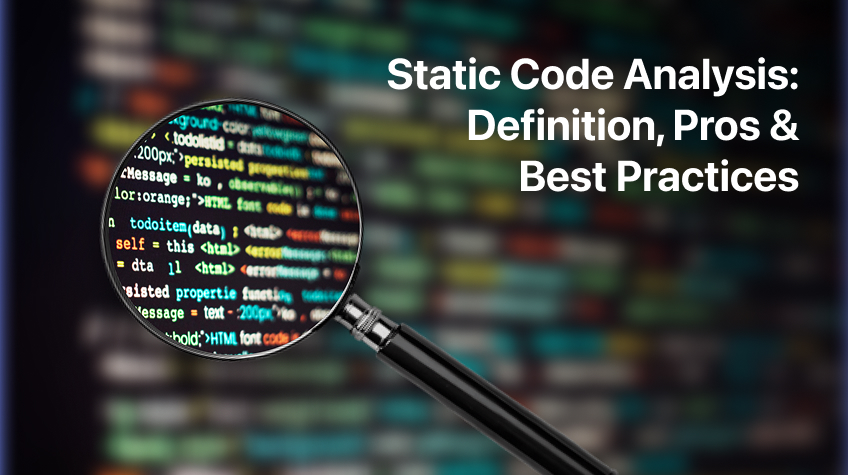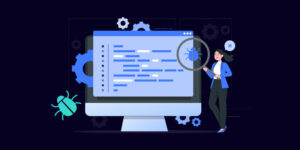
Software bugs are like weeds. They don’t ask for permission; they just grow where they please. It does not matter how talented your developers are; human error happens. And static code analysis, or SCA (remember this because we’re going to use this a lot), has become a silent superhero that catches thieves (flaws) before the code even gets a chance to run.
Is it worth a try? We’ll definitely say yes. But so it’s more convincing and comprehensible for you, we’ll start with the basics.
What Is Static Code Analysis?

In simpler words, static code analysis is the process of examining source code without executing the code. It finds potential bugs, security vulnerabilities, and other violations before any code breach can turn into a production nightmare.
An SCA tool combs through your codebase, identifies the weak spots (from uninitialized variables to potential injection points) with a set of predefined rules or machine learning models. So, you don’t have to run the software beforehand and see it burn in front of your eyes.
Why It Matters?
Static code analysis identifies and mitigates risks before they reach production environments. Security breaches don’t just cost a lot of money; they’re reputation killers. Organizations have to secure the software supply chain and implement development practices early to reduce vulnerabilities and maintain software integrity.
But it’s also about quality and efficiency. Every developer dreads code disasters. And continuous static analysis can prevent those, while enforcing best practices across teams, and improving readability. If you want smoother collaboration and faster onboarding, keep your code consistent.
Static Application Security Testing, or SAST, tools nowadays go even further. They integrate into your CI/CD pipeline and provide real-time feedback. They allow devs to ship, clean, and secure code faster. It’s definitely worth adding an integrated SAST tool for static code analysis to your system, so it automatically points out issues, suggests fixes, and filters out false positives.
The Pros of Static Code Analysis
- Early Detection, Lower Costs: The earlier you catch the bug, the cheaper (and easier) it will be to get rid of it. You can prevent shipping risky code because static analysis catches vulnerabilities at the source.
- Stronger Security Posture: SCA is your first line of defense. Of course, that’s if you know your vulnerability patterns (like SQL injection or cross-site scripting). Forewarned is forearmed, right?
- Continuous Improvement: SCA tools automatically scan and report EVERYTHING. What that means for devs is that cleaning the mistakes becomes more of a habit. Over time, even that becomes unnecessary as devs start to write the code by default.
- Language and Framework Agnostic: Static analysis adapts to multiple programming languages and frameworks. So, you can be sure that your entire technology stack is protected under one roof.
- Better Collaboration Across Teams: When everyone speaks the same “code quality” language, everything else (including devs, testers, and security engineers) aligns naturally. SCA reduces friction, so that everyone can work towards a safer, more stable product.
Best Practices for Implementing Static Code Analysis

1. Make It Part of Your CI/CD Pipeline
Running static analysis manually defeats its purpose. To automatically check everything in real time, so you won’t miss any pull requests or commits, connect SCA to your pipeline. You’ll end up with consistent quality and fast-working devs.
2. Prioritize Findings Based on Risk
Fine-tune your SCA to filter out false positives and make actionable reports. Not all warnings are equal. This will make sure that you focus first on higher-severity issues that pose actual threats.
3. Educate Your Developers
Any tool is effective when people know how to use it. Based on your SCA results, you can host internal workshops or quick training sessions, so errors turn into learning opportunities, eventually leading to codebase (and team) growth.
4. Combine Static and Dynamic Analysis
Static analysis alone does a lot of work. But it can’t catch runtime issues alone. If you pair it with dynamic testing to simulate real-world attacks, both your code and your execution paths will be secure.
5. Track Metrics Over Time
Measure improvements once in a while. Then analyze, analyze, and analyze again. Keep an eye on how many vulnerabilities are being caught early vs in production. That’s how you can demonstrate ROI and justify ongoing security investments.
Beyond Code: The Future of SCA
Modern static analysis tools can’t be called simply security checkpoints. They have turned into intelligent collaborators, as they do more than just scan for errors. They actually learn from your projects, so they can adapt to your coding style and offer context-aware suggestions. You’ll know what’s wrong, and you’ll understand why it happens in the first place.
As software systems become increasingly interconnected, the principles behind SCA also expand. The approach to reviewing and refining code has always been disciplined. However, it now also extends to growth, documentation, and even linkable assets. Because developing continuously doesn’t just include clean code. It’s an ecosystem that is transparent, collaborative, and focused on learning.
Also Read: Top AI Tools to Improve Your Coding
Wrapping Up
Static code analysis is no longer a “nice to have.” As teams adapt to more active workflows and faster release cycles, it has become an important part of modern software development. SCA steps into a new role. If it used to simply detect issues, now it shapes how teams think, build, and collaborate.
AI-driven SCA platforms are already leaning towards more precise, real-time guidance. This makes static analysis turn into a partner that evolves alongside your development process.
So shortly, static code analysis doesn’t only prevent vulnerabilities. It creates a system to reinforce quality, security, and innovation. Remember, clean code is a standard, not an exception.






